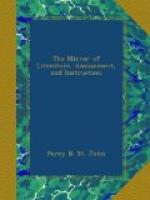We could occupy many pages with the interesting details of Sir Humphry Davy’s travels in different parts of Europe for scientific purposes, particularly to investigate the causes of volcanic phenomena, to instruct the miners of the coal districts in the application of his safety-lamp, and to examine the state of the Herculaneum manuscripts and to illustrate the remains of the chemical arts of the ancients. He analyzed the colours used in painting by the ancient Greek and Roman artists. His experiments were chiefly made on the paintings in the baths of Titus, the ruins called the baths of Livia, in the remains of other palaces and baths of ancient Rome, and in the ruins of Pompeii. By the kindness of his friend Canova, who was charged with the care of the works connected with ancient art in Rome, he was enabled to select with his own hands specimens of the different pigments, that had been formed in vases discovered in the excavations, which had been lately made beneath the ruins of the palace of Titus, and to compare them with the colours fixed on the walls, or detached in fragments of stucco. The results of all these researches were published in the Transactions of the Royal Society for 1815, and are extremely interesting. The concluding observations, in which he impresses on artists the superior importance of permanency to brilliancy in the colours used in painting, are especially worthy the attention of artists. On his examination of the Herculaneum manuscripts, at Naples, in 1818-19, he was of opinion they had not been acted upon by fire, so as to be completely carbonized, but that their leaves were cemented together by a substance formed during the fermentation and chemical change of ages. He invented a composition for the solution of this substance, but he could not discover more than 100 out of 1,265 manuscripts, which presented any probability of success.
Sir Humphry returned to England in 1820, and in the same year his respected friend, Sir Joseph Banks, President of the Royal Society, died. Several discussions took place respecting a proper successor, when individuals of high and even very exalted rank were named as candidates. But science, very properly in this case, superseded rank. Amongst the philosophers whose labours had enriched the Transactions of the Royal Society, two were most generally adverted to, Sir Humphry Davy and Dr. Wollaston; but Dr. Wollaston very modestly declined being a candidate after his friend had been nominated, and received from the council of the Society the unanimous compliment of being placed in the chair of the Royal Society, till the election by the body in November.[3] A trifling opposition was made to Sir Humphry Davy’s election, by some unknown persons, who proposed Lord Colchester, but Sir Humphry was placed in the chair by a majority of 200 to 13. For this honour no one could be more completely qualified. Sir Humphry retained his seat as President till the year 1827, when, in consequence of procrastinated ill health, in great measure brought on by injuries occasioned to his constitution by scientific experiments, he was induced, by medical advice, to retire to the continent. He accordingly resigned his seat as President of the Royal Society, the chair being filled, pro tem, by Davies Gilbert, Esq. who, at the Anniversary Meeting, Nov. 30, 1827, was unanimously elected President.




